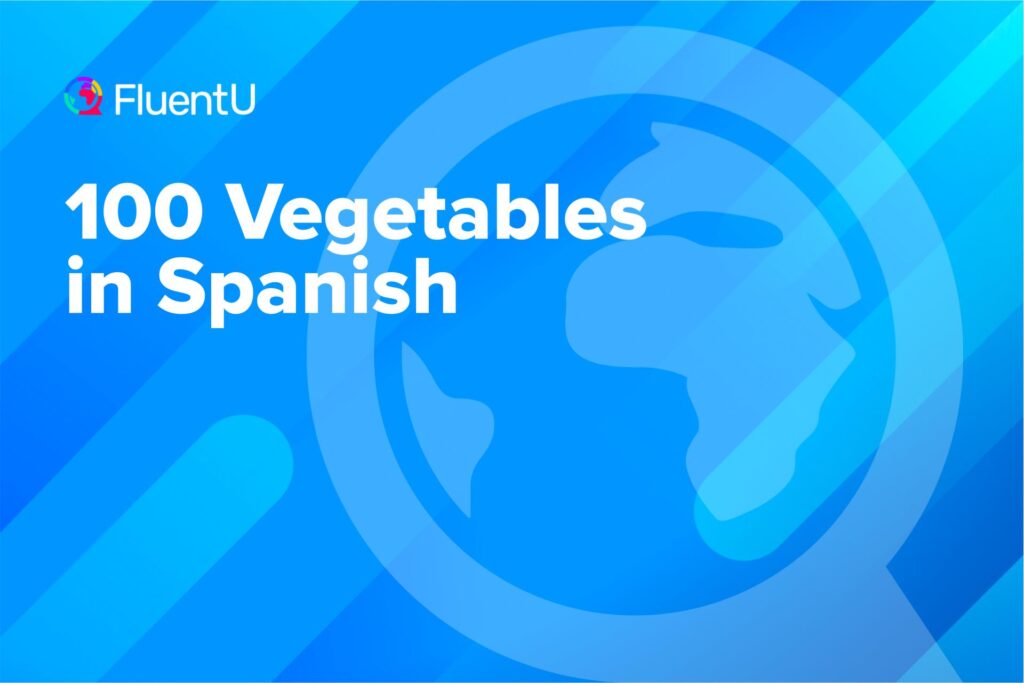100 Vegetables in Spanish

Imagine strolling through vibrant markets in Madrid or Barcelona, confidently pointing out the freshest tomate (tomato) for your salad or the perfect calabacín (zucchini) for a mouthwatering dish.
That dream will be a little closer after finishing this post on common (and not-so-common) vegetables in Spanish, so read on to get started.
Download: This blog post is available as a convenient and portable PDF that you can take anywhere. Click here to get a copy. (Download)
How to Say “Vegetables” in Spanish: Verduras
The word for “vegetable” in Spanish is verdura , while “vegetables” is verduras . The word verdura has its roots in Latin, deriving from verde, which means “green.”
In Spanish, verdura refers to various types of edible plants, primarily vegetables. It’s worth noting that while the word itself is feminine, it’s commonly used to refer to both masculine and feminine nouns.
Here are a couple of example sentences:
Asegúrate de incluir verdura en todas tus comidas para mantener una dieta saludable. (Make sure to include vegetables in all your meals to maintain a healthy diet.)
Me encanta cocinar con verduras frescas. (I love cooking with fresh vegetables.)
En esta receta, las verduras son el ingrediente principal. (In this recipe, the vegetables are the main ingredient.)
Vegetable Vocabulary in Spanish
Root Vegetables
A root vegetable is a type of edible plant where the part that is consumed is the underground portion, typically the root, tuber or bulb. Root vegetables often store a significant amount of nutrients and energy in their underground parts, making them valuable sources of vitamins, minerals, and carbohydrates.
| Spanish | English |
|---|---|
| Verduras de raíz | Root vegetables |
| La zanahoria | Carrot |
| La papa | Potato |
| La batata | Sweet potato |
| El rábano | Radish |
| El nabo | Turnip |
| La remolacha | Beet |
| El nabo sueco | Rutabaga |
| La chirivía | Parsnip |
| La cebolla | Onion |
Cruciferous Vegetables
These delicious veggies are known for their distinctive four-petal cross-shaped flowers, which is where the name “cruciferous” originates. They’re highly nutritious and are often recognized for their potential health benefits, including being rich in vitamins, minerals and fiber.
| Spanish | English |
|---|---|
| Las verduras crucíferas | Cruciferous Vegetables |
| El brócoli | Broccoli |
| La coliflor | Cauliflower |
| El repollo | Cabbage |
| La col de bruselas | Brussels sprout |
| La col rizada | Kale |
| Las hojas de berza | Collard greens |
| El bok choy | Bok choy |
| El rábano daikon | Daikon radish |
| La rúcula | Arugula |
| El berro | Watercress |
| Las hojas de mostaza | Mustard greens |
| Las hojas de nabo | Turnip greens |
| El rábano picante | Horseradish |
Legumes and Pods
A legume is a type of plant whose fruit is enclosed in a pod. They play a significant role in agriculture and human diets due to their nutritional value and ability to fix nitrogen in the soil.
| Spanish | English |
|---|---|
| Las legumbres | Legumes |
| Los garbanzos | Chickpeas / Garbanzo beans |
| Los frijoles negros | Black beans |
| Los frijoles rojos | Kidney beans |
| Los frijoles pintos | Pinto beans |
| Los frijoles blancos | Navy beans |
| Las habas | Lima beans |
| Los frijoles mungo | Mung beans |
| Los frijoles azuki | Adzuki beans |
| Los frijoles arándano | Cranberry beans |
| Las habas | Favabeans/Broad beans |
| Los guisantes verdes | Green peas |
| Las vainas de guisantes | Snow peas |
| Los guisantes crujientes | Snap peas |
| Las lentejas partidas | Split peas |
| Las alubias ojo negro | Black-eyed peas |
| Las habas de soja | Soybeans |
| Las edamames | Edamame |
| Las lentejas | Lentils |
| Las lentejas rojas | Red lentils |
| Las lentejas verdes | Green lentils |
Allium Vegetables
Allium vegetables belong to the Alliaceae family and are known for their distinct flavor and aroma. They’re widely used in cooking to enhance the taste of various dishes and also offer potential health benefits.
| Spanish | English |
|---|---|
| Las verduras allium | Allium vegetables |
| La cebolla | Onion |
| El ajo | Garlic |
| El chalote | Shallot |
| El puerro | Leeks |
| El cebollín | Scallion/Green onion |
| La cebollina | Chive |
Leafy Greens
These leafy greens are rich in vitamins, minerals and antioxidants, making them important components of a healthy diet.
| Spanish | English |
|---|---|
| Las verduras de hojas verdes | Leafy greens |
| Las espinacas | Spinach |
| La col rizada | Kale |
| La lechuga | Lettuce |
| La lechuga iceberg | Iceberg lettuce |
| La lechuga romana | Romaine lettuce |
| La acelga suiza | Swiss chard |
| Las hojas de berza | Collard greens |
| La rúcula | Arugula |
| Las hojas de mostaza | Mustard greens |
| Las hojas de nabo | Turnip greens |
| Las hojas de remolacha | Beet greens |
| El bok choy | Bok choy |
| El berro | Watercress |
| La achicoria roja | Radicchio |
| La endibia | Endive |
| La escarola | Escarole |
| La lechuga romana | Romaine |
| La col | Cabbage |
| La acedera | Sorrel |
| La verdolaga | Purslane |
Miscellaneous Vegetables
These vegetables offer a wide range of flavors and textures, and they can be used in various culinary applications.
| Spanish | English |
|---|---|
| El espárrago | Asparagus |
| La alcachofa | Artichokes |
| El quimbombó | Okra |
| La berenjena | Eggplant |
| El pepino | Cucumber |
| El pimiento | Bell pepper |
| El tomate | Tomato |
| El tomatillo | Tomatillo |
| El calabacín | Zucchini |
| El calabacín de verano | Summer squash |
| El calabacín de invierno | Winter squash |
| El apio | Celery |
| El ruibarbo | Rhubarb |
| Los brotes de bambú | Bamboo shoots |
| El tupinambo | Jerusalem artichokes |
| El colirrábano | Kohlrabi |
| El repollo chino | Chinese cabbage |
Regional Vegetables Across the Spanish-speaking World
Hungry for more? Here are some regional vegetables from different parts of the Spanish-speaking world:
- Yuca (Cassava) — Common in Latin America and the Caribbean, yuca is a starchy root vegetable used in various dishes, including soups, stews and fried food.
- Jicama — Found in Mexico and Central America, jicama is a crunchy, slightly sweet root vegetable often enjoyed raw in salads or as a refreshing snack.
- Aji Amarillo — This yellow chili pepper is a staple in Peruvian cuisine. It’s used to add flavor and heat to dishes like ceviche and causa.
- Malanga — Popular in the Caribbean and parts of Central and South America, malanga is a root vegetable that can be cooked in similar ways to potatoes.
- Chayote — Widely consumed in Latin America, particularly in Mexico, chayote is a green, pear-shaped vegetable often used in salads, soups and stews.
- Calçots — Hailing from Catalonia in Spain, calçots are a type of green onion or scallion that is typically grilled and served with romesco sauce.
- Nopal (Prickly Pear Cactus) — A key ingredient in Mexican cuisine, nopal is a cactus plant known for its edible paddles. It’s used in salads and tacos, among other dishes.
- Taro — Popular in Puerto Rico and other parts of the Caribbean, taro is a starchy root vegetable that can be boiled, fried or used in stews.
- Auyama (West Indian Pumpkin) — Common in the Caribbean, auyama is a type of squash used in soups, stews and even desserts.
- Picante de Cayena — Cayenne pepper is used extensively in Dominican Republic cuisine to add a spicy kick to dishes and sauces.
These delicious vegetables might be healthy for your body but the Spanish vegetable vocabulary words are healthy for your brain! Practice them by using them in conversations or watching them in use naturally on FluentU’s many videos.
FluentU takes authentic videos—like music videos, movie trailers, news and inspiring talks—and turns them into personalized language learning lessons.
You can try FluentU for free for 2 weeks. Check out the website or download the iOS app or Android app.
P.S. Click here to take advantage of our current sale! (Expires at the end of this month)

Learn them and use them, whether you’re ordering a meal in a restaurant or narrating your own cooking as though you’re a contestant in “Top Chef,” Spanish edition.
And One More Thing…
If you've made it this far that means you probably enjoy learning Spanish with engaging material and will then love FluentU.
Other sites use scripted content. FluentU uses a natural approach that helps you ease into the Spanish language and culture over time. You’ll learn Spanish as it’s actually spoken by real people.
FluentU has a wide variety of videos, as you can see here:

FluentU brings native videos within reach with interactive transcripts. You can tap on any word to look it up instantly. Every definition has examples that have been written to help you understand how the word is used. If you see an interesting word you don’t know, you can add it to a vocab list.

Review a complete interactive transcript under the Dialogue tab, and find words and phrases listed under Vocab.

Learn all the vocabulary in any video with FluentU’s robust learning engine. Swipe left or right to see more examples of the word you’re on.

The best part is that FluentU keeps track of the vocabulary that you’re learning, and gives you extra practice with difficult words. It'll even remind you when it’s time to review what you’ve learned. Every learner has a truly personalized experience, even if they’re learning with the same video.
Start using the FluentU website on your computer or tablet or, better yet, download the FluentU app from the iTunes or Google Play store. Click here to take advantage of our current sale! (Expires at the end of this month.)







